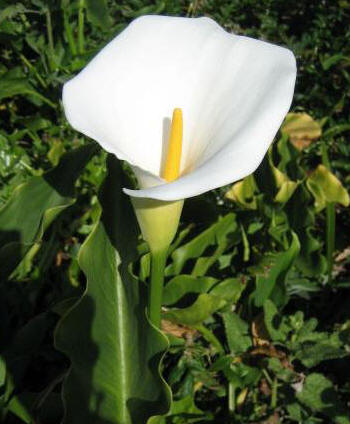
| The calla lily is an autotrophic organism. It is able to
produce its own food as long as it has enough water, CO2, and
sunlight. To obtain the water, it must be transported from the
roots to the leaves. It is able to do so by using specialized
structures called xylem cells. On the leaves themselves there are pore
openings called stomata. These stomata have the ability of opening
and closing. For the process of photosynthesis to occur the
stomata must open so Carbon Dioxide can be let in, the problem that
occurs because of this process is that water is lost through the pores
so more water is needed because it is being let out. In the
presence of sunlight the pigment chlorophyll absorbs all the wavelengths
of visible light except for green which is reflected. This
reflection of green is what we see when we look at green leaves.
Photosynthesis includes two stages. The first stage is the light dependent reactions which occur in the grana in the inner membrane of the chloroplasts. The energy involved is usually from the sun however it can be artificially produced. This energy creates energy carrier molecules that can be used in the light independent reactions. During this stage which occurs in the stroma of the chloroplasts carbon-carbon bonds are created. These carbohydrates are then able to provide energy for the plant. Extra food in the calla lily can be stored in the rhizome. These rhizome commonly called tubers can grow to be extremely large in size. In the presence of enough water and plenty of sunlight the calla lily is very likely to do well. It does not have specific soil needs and is able to resist minor frost. However in very cold or hot conditions the plant will not be able to survive.
This page is maintained by Ashley Schultz schultz.ash2@students.uwlax.edu
|
